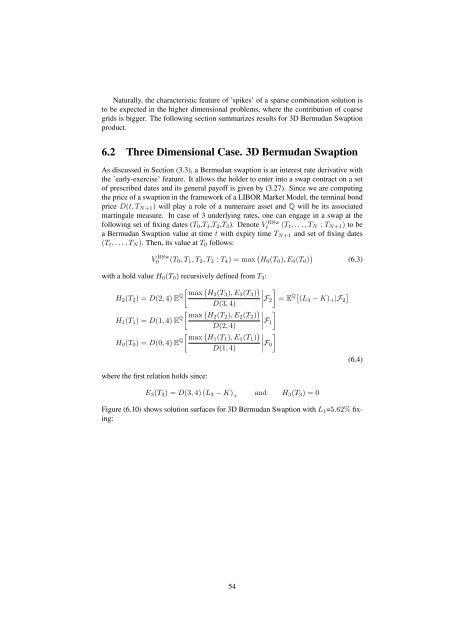sparse grid method in the libor market model. option valuation and the
sparse grid method in the libor market model. option valuation and the
sparse grid method in the libor market model. option valuation and the
You also want an ePaper? Increase the reach of your titles
YUMPU automatically turns print PDFs into web optimized ePapers that Google loves.
Naturally, <strong>the</strong> characteristic feature of ’spikes’ of a <strong>sparse</strong> comb<strong>in</strong>ation solution is<br />
to be expected <strong>in</strong> <strong>the</strong> higher dimensional problems, where <strong>the</strong> contribution of coarse<br />
<strong>grid</strong>s is bigger. The follow<strong>in</strong>g section summarizes results for 3D Bermudan Swaption<br />
product.<br />
6.2 Three Dimensional Case. 3D Bermudan Swaption<br />
As discussed <strong>in</strong> Section (3.3), a Bermudan swaption is an <strong>in</strong>terest rate derivative with<br />
<strong>the</strong> ’early-exercise’ feature. It allows <strong>the</strong> holder to enter <strong>in</strong>to a swap contract on a set<br />
of prescribed dates <strong>and</strong> its general payoff is given by (3.27). S<strong>in</strong>ce we are comput<strong>in</strong>g<br />
<strong>the</strong> price of a swaption <strong>in</strong> <strong>the</strong> framework of a LIBOR Market Model, <strong>the</strong> term<strong>in</strong>al bond<br />
price D(t, T N+1 ) will play a role of a numeraire asset <strong>and</strong> Q will be its associated<br />
mart<strong>in</strong>gale measure. In case of 3 underly<strong>in</strong>g rates, one can engage <strong>in</strong> a swap at <strong>the</strong><br />
follow<strong>in</strong>g set of fix<strong>in</strong>g dates (T 0 ,T 1 ,T 2 ,T 3 ). Denote Vt<br />
BSw (T t , . . . , T N : T N+1 ) to be<br />
a Bermudan Swaption value at time t with expiry time T N+1 <strong>and</strong> set of fix<strong>in</strong>g dates<br />
(T t , . . . , T N ). Then, its value at T 0 follows:<br />
V BSw<br />
0 (T 0 , T 1 , T 2 , T 3 : T 4 ) = max ( H 0 (T 0 ), E 0 (T 0 ) ) (6.3)<br />
with a hold value H 0 (T 0 ) recursively def<strong>in</strong>ed from T 3 :<br />
[ (<br />
max<br />
H 2 (T 2 ) = D(2, 4) E Q H3 (T 3 ), E 3 (T 3 ) )<br />
]<br />
D(3, 4) ∣ F 2 = E Q[ ]<br />
(L 3 − K) + |F 2<br />
[ (<br />
max<br />
H 1 (T 1 ) = D(1, 4) E Q H2 (T 2 ), E 2 (T 2 ) )<br />
]<br />
D(2, 4) ∣ F 1<br />
[ (<br />
max<br />
H 0 (T 0 ) = D(0, 4) E Q H1 (T 1 ), E 1 (T 1 ) )<br />
]<br />
D(1, 4) ∣ F 0<br />
where <strong>the</strong> first relation holds s<strong>in</strong>ce:<br />
E 3 (T 3 ) = D(3, 4) (L 3 − K) +<br />
<strong>and</strong> H 3 (T 3 ) = 0<br />
(6.4)<br />
Figure (6.10) shows solution surfaces for 3D Bermudan Swaption with L 1 =5.62% fix<strong>in</strong>g:<br />
54
















